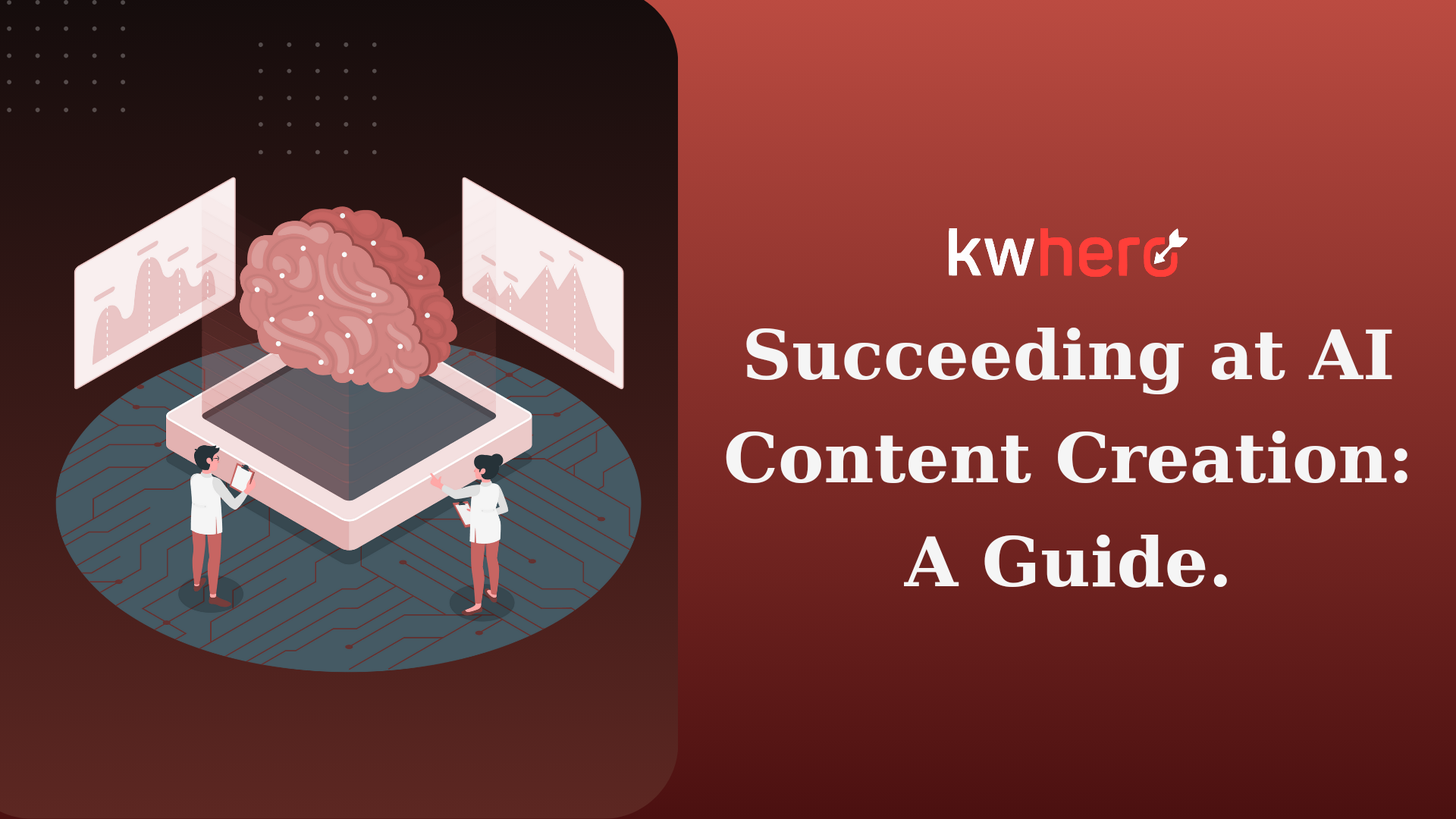Without wasting any time adding to the infinite echo chamber, I’ll get this out of the way — AI in content creation and marketing is here to stay. This article’s primary purpose is to help you leverage it for success in content creation and strategy.
First Things First
It’s important to address two things before we talk about anything else.
What Google Thinks of AI in Content Creation
Whenever artificial intelligence comes up, the default train of thought among a good few content specialists is that Google is out to take down AI content in all its forms because it is “low quality content.”
I cannot entirely say that I do not understand that sentiment, considering Google’s call out on “automation” in the March 2024 Helpful Content Update.
But, here’s the thing — Google is not against AI in content creation. The reason it seems that Google is opposed to it is that artificial intelligence is often abused.
People produce hundreds of articles, leveraging AI’s efficiency, to beat search engines as opposed to serving the users/readers. That is what Google is against, not artificial intelligence in content creation specifically.
Google’s guide on AI for content creation makes that clear and advises content specialists to focus on Experience, Expertise, Authoritativeness and Trust (E-E-A-T) because they care more about quality than the method of content production.
To put it simply, Google doesn’t mind if you produce AI content. As long as the content is still high-quality, you’re good.
What You Should Think of AI in Content Creation
For starters, artificial intelligence is not out to replace you. It is designed to assist you. Being a content specialist myself, I won’t pretend I’ve never had a headache about AI.
AI in content creation and strategy introduces new levels of efficiency that could potentially cut down several hours of content marketing work, leading to the re-evaluation of some jobs.
But, ultimately, the point is for you to use AI to assist your research and writing process.
KWHero, for example, will give you a list of your competitors for a keyword at a glance and select the best ones to use for research by default.
It would also suggest headings, terms and questions you should cover in your content alongside a comprehensive outline that incorporates all the suggestions for you to work on.
Doing so cuts the research time drastically and you can focus on other aspects of content creation and strategy that require your attention.
Secondly, while artificial intelligence holds a lot of promise for content specialists, it’s still important for you to manage your expectations. As I established earlier, it’s a tool you’re meant to use to improve your processes.
But, like every other man-made tool, it is imperfect. It’s your job to improve it as much as possible by introducing a human angle. We’ll go deeper into this later in the article.
Finally, keep in mind that artificial intelligence has tons of other uses outside of content creation and writing itself. We’ll give a broad overview and make some decent recommendations but our focus will largely be on content creation.
Using AI for Content Creation: Steps to Succeed
There are three key stages of content creation – strategy and research, execution/writing and distribution. All three can be augmented with AI with impressive results to show for it.
1. Strategy and Research
If you stay in content marketing long enough, you’ll realize very quickly that starting anything in this line of work without a real strategy is the marketing equivalent of throwing spaghetti at the wall and hoping at least one of them will stick.
If you’re lucky – and I mean really lucky – you might do a bunch of random things, put some words on the internet and you’ll go viral for it. Unfortunately, that sort of luck is difficult to repeat.
So, needless to say, your first step should be to get your feet on the ground and build a research-driven strategy.
For a full-scale content marketing strategy, the process is long and windy, involving everything from analyzing your competitors and audience to figuring out distribution channels. Diving into that would require nothing short of a full course.
For a simple/one-off article, you’re focusing more on research and building a solid outline that guarantees that your audience can and will get something useful from the entire piece. This is where our attention lies.
Where AI Should Come In
There are three key steps you’ll need to cover in this stage:
- Keyword research
- Competitor analysis
- Outline generation
Keyword research here would come down to finding and analyzing the primary keyword you would like to rank for, looking for secondary keywords to support the same, and building a cluster if the topic has the opportunity for it.
With an AI-powered tool like KWHero, all three actions I mentioned earlier are possible in one page and at a glance.
You’ll start with a root keyword idea. If you haven’t decided what your primary keyword should be, it can be anything that’s related to your topic. In the screenshot below, we simply put in “artificial intelligence.”
Right after, we were able to get hundreds of keywords in the United States alone.

The keyword difficulty, cost per click, search trends and SERPs were also available and it only took a few clicks.

Competitor analysis with KWHero takes a slightly different turn than you might expect. As we described earlier, inputting a primary keyword will get you a list of all your competitors currently on the SERPs like so:
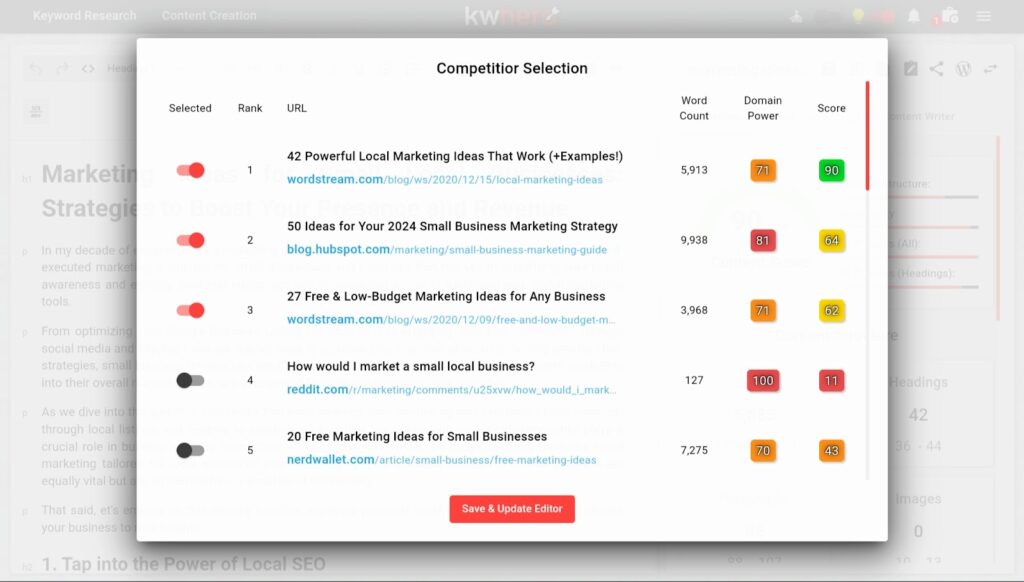
From this screen, you can toggle each option on and off. Depending on what you choose, KWHero will go through all their content and use their primary headings and keywords to determine what’ll go into your article.
Outline generation comes right after, if you prefer, and is based on the competitors you earlier selected.
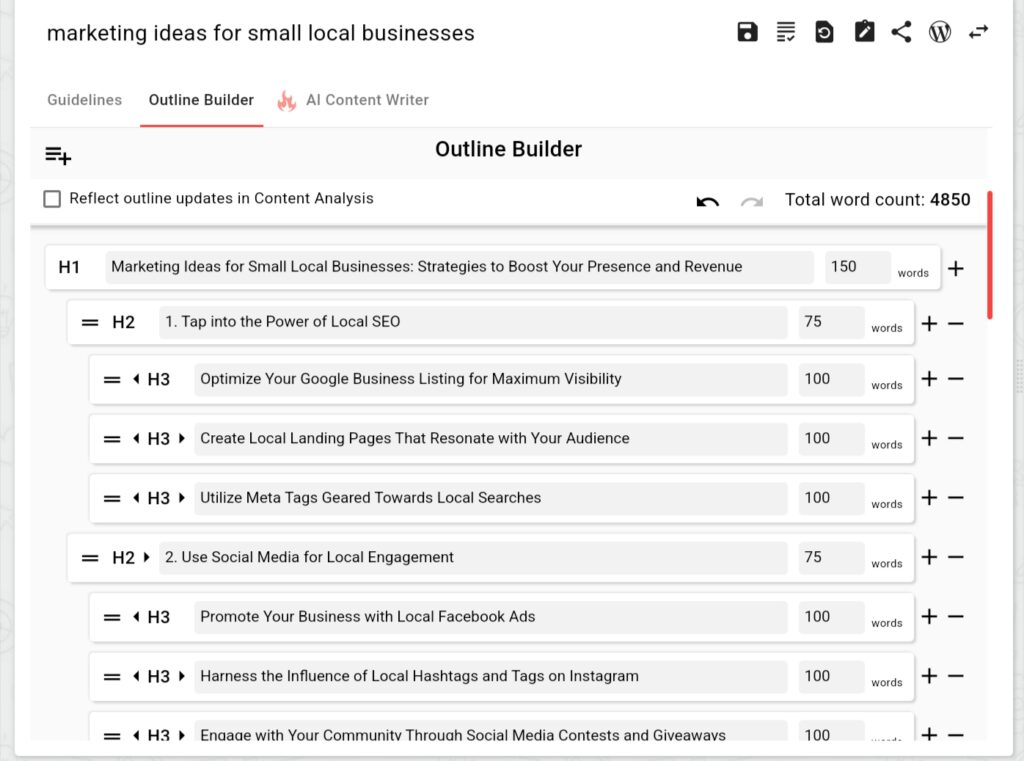
So, in three basic screens, you’ve completed all the basic research necessary before writing an article and you still have several hours left to do pretty much anything else you’re psyched to do.
2. Execution – Writing and Editing
Nearly every writer on the planet has been there.
You’re sitting in front of your laptop or tablet but you cannot bring yourself to write anything that you do not instantly judge terrible. So, you spend hours thinking, writing, hitting the backspace button and repeating that process.
AI in content creation eliminates that with unbelievable ease. But painting that alone as the sole or even main advantage of AI is an understatement of how artificial intelligence contributes to the success of the writing process.
Where AI Should Come In
Of course, speed is a major USP and with speed alone, you can scale your content strategy noticeably by simply putting out more content and seeing what works vs what doesn’t.
But, beyond speed, AI also does two key things at the writing stage:
- It can efficiently cover all the basics of SEO by compiling NLP terms and keywords you need to see results on your content.
- It can produce a (near) perfect first draft for you, complete with earlier mentioned keywords and NLP phrases.
You see, these two abilities are important because for all of Google’s unbeatable monopoly on the search engine industry, their company is essentially one gigantic software.
It is incapable of reading and understanding human text in the same way that we do. It has to rely on billions of lines of code as well as natural language processing, which, among other things, judges meaning and makes ranking decisions based on words and how they relate to each other.
As an individual, you cannot find those words accurately without dedicating a large amount of your time to research with a lot of guesswork sprinkled in. With AI, it’s as straightforward as you can imagine.
KWHero, for example, will generate a list of terms for you as soon as you create a content analysis.

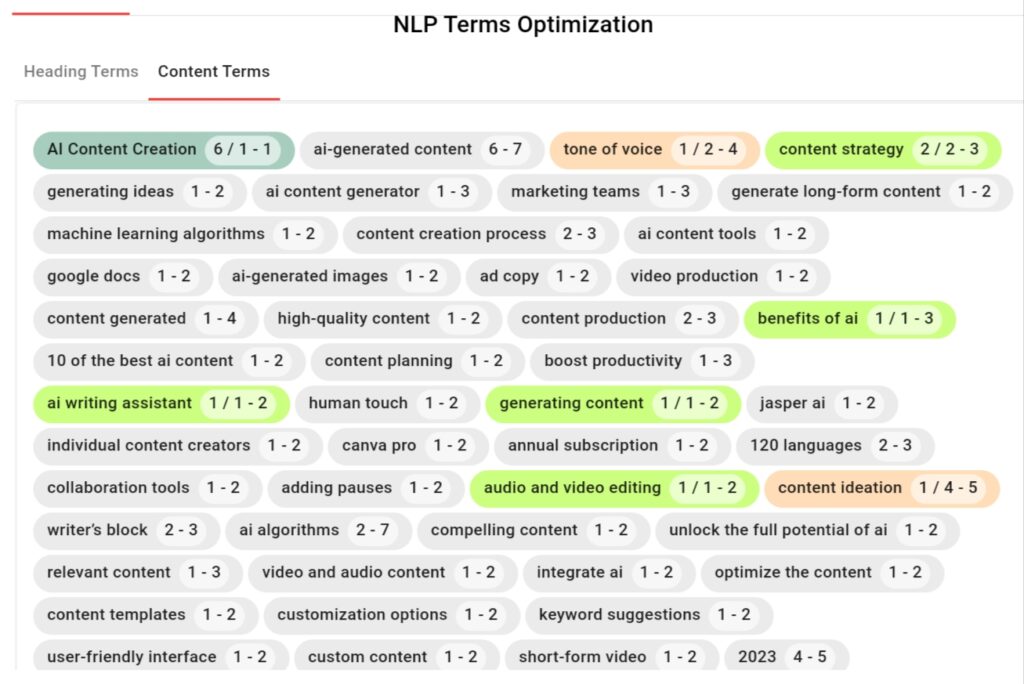
Once you set it to generate the content for you, it includes as many of the key terms initially outlined right off the bat without you needing to include them manually.
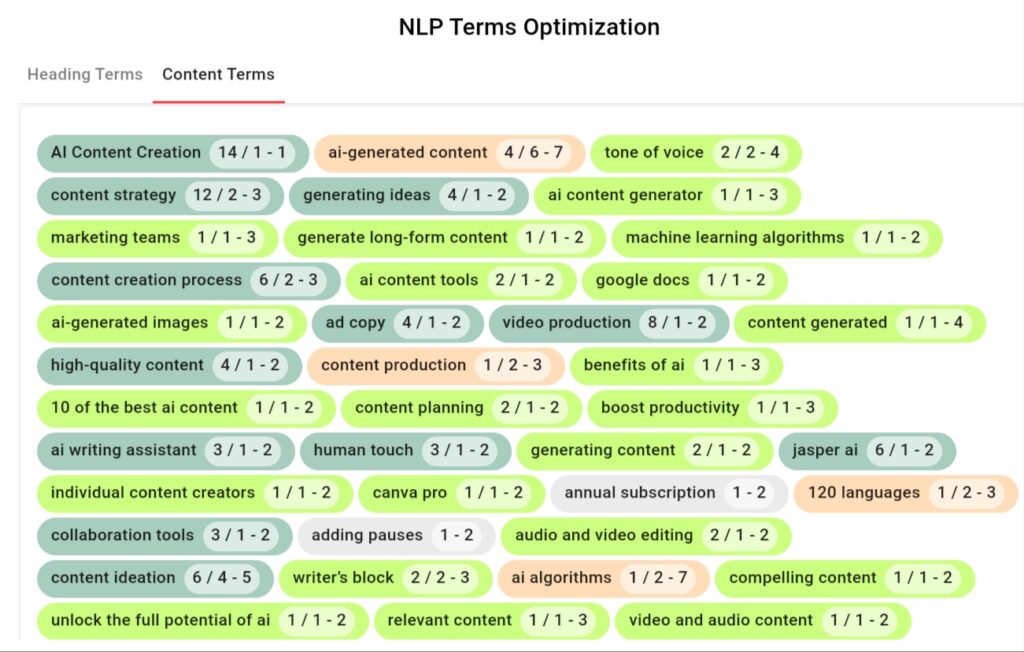
This might seem basic on the surface, especially when you consider that it required minimal contribution from your end. But, in reality, it is this type of precise research and writing that generates results. You don’t have to take our word for it, though.
Tips for Making the Most of Your Writing Process with AI
All the tips in this section can be squeezed into one principle — get involved.
As I mentioned earlier, artificial intelligence is a tool and you still have to make its output better by introducing a human angle. The top three ways you can do that are:
a. Do your research first.
This is especially important if it’s a niche topic or industry that could benefit from an expert interview. AI can not come up with the idea of getting an expert on a topic to agree to an interview and provide valuable insights. It also cannot come up with questions relevant to your topic or do so against the backdrop of an in-depth understanding of your company. At least, not without extensive prompting.
All that is up to you and, even though it doesn’t need to be said, adding an expert’s perspective could do wonders for your content. Not only does it enrich it but you’ll also be able to get the expert to share your content to their peers, giving you the opportunity to broaden your distribution network.
If, on the other hand, your content is not super niche, you can just do some light research and see what others are already saying about the subject. That way, you can gain useful context for the next tip.
b. Prompt your AI tool extensively.
In my opinion, there’s no such thing as too many prompts. If there is, you’ll have a hard time hitting the limit. So, just before you write, based on the knowledge you already gathered on the topic, prompt your AI tool extensively.
With KWHero, you have two opportunities to do this. The first is at the stage of outline building.
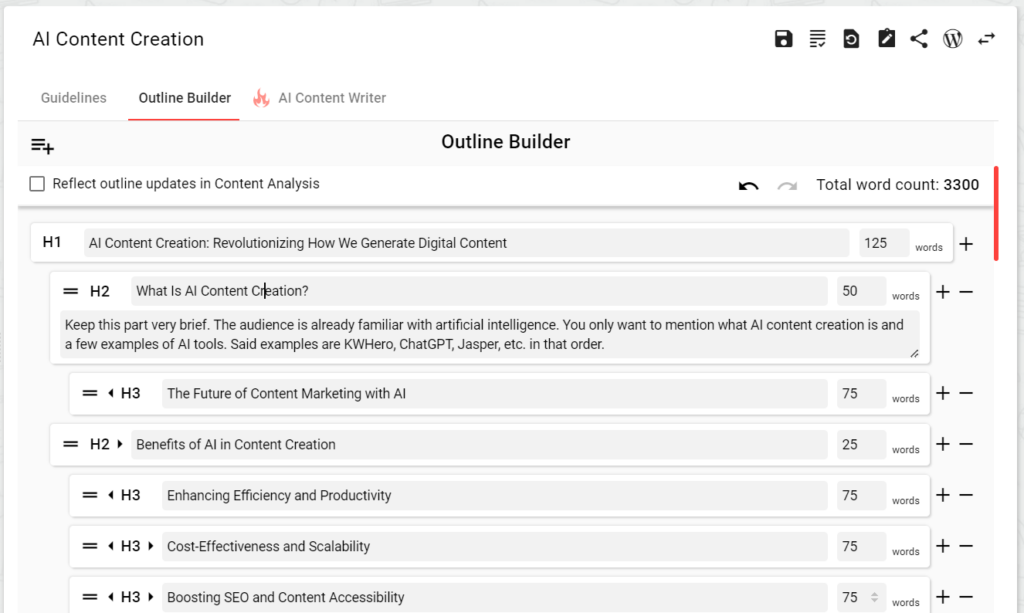
Note the text field under the second heading in the screenshot above? That’s a prompt.
Another opportunity to give KWHero a useful prompt is in the “Additional Guidelines” section before the article is generated.

By specifying what you want in these places, you ensure that the final output is as close to your preference as possible. Similar results can be achieved on several other AI content creation tools.
c. Edit the first draft if you can.
Generally, some of the best AI tools can produce excellent content on the first draft, especially if you’re judging from the lens of grammatical accuracy only. But, that’s not all that matters in content, is it?
Sometimes, AI can be a little off the mark. This largely happens because of the prompts you feed it or some other mistake. Either way, with Google constantly hammering on quality of content, it’s never a bad idea to edit the first draft.
We do this all the time and the things we look out for are:
- Accuracy of the information given.
- Flow and consistency throughout the article. AI sometimes has difficulty transitioning between sections in an article. With KWHero, that can be fixed with outline prompts but we do a double take just to be sure we missed nothing.
- Opportunities to improve content with expert opinion. Not all information is available online for AI to infuse into the content. To keep the articles as high-quality as possible, I’ll advise infusing expert opinions, personal experiences, etc. All these make for good content.
3. Distribution
This stage of the content creation process is pretty straightforward so I’ll keep it short.
Most people tend to forget that Google is simply a distribution channel for your content. But, it should not necessarily be your sole distribution channel, especially if you’re looking to attract a decent amount of traffic and hopefully convert them.
Ideally, you should be sharing your content on social pages, forums and any other channel your audience hangs out on.
Where AI Should Come In
The best way to do that is to repurpose your content with AI tools and repost those recycled content pieces onto social channels. Several tools on the market can help with this.
Automata, for example, can turn blogs into Twitter threads. Buffer’s AI assistant can do the same with several extra features thrown in there for good measure. Once you’ve repurposed your content efficiently using AI, you can go ahead and share across relevant social channels.
The most obvious choice is to simply include a link at the bottom of the repurposed content so that it acts as a teaser and you can send your audience to your site.
In the alternative, you can instead just leave the repurposed version there but keep your branding strong. That way, you’re not directing traffic but you’re keeping your audience meaningfully engaged exactly where they want to be.
Wrapping Up
Given the incredible improvements we’ve seen in the last few years, it’s safe to say that AI isn’t slowing down anytime soon. There are several different applications of this emerging technology. Choosing to pay no attention to it for your marketing needs would leave you missing out at best or actively harming yourself in the worst case scenario.
My advice? Give it a shot. KWHero is a great place to start and with improvements to the software coming up as we go, it’ll only get better from here. Sign up now to get started.
PS. If you want to see the AI-generated article we kept referencing in our examples above, click here.
